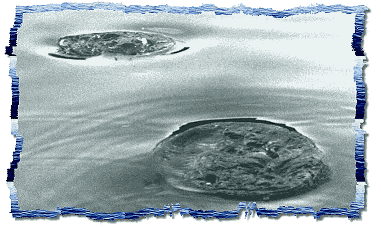Reading rise forms
Arrrggggg! Just what are they eating?
by Clive Schaupmeyer
Adapted from The Essential Guide to Fly-Fishing by the author.

Rise forms are the water patterns-ripples, rings, bubbles, and
swirls-made by trout feeding at or near the surface. Individual forms
are of interest, but there are two important things to learn or accept
first
A) A rise only tells you there is a fish in the water, and
B) To figure out what the fish is eating, and to catch it, you may have
to pay close attention.
If you take the time to watch and try to understand what it is you are
seeing, then half the battle of dry-fly fishing is won.
"This sounds like bull, to me," you say, "The fish are rising, so all I
do is tie on a brown fly because there are brown mayflies on the water."
Hopefully that's true. You see fish rising; you take a quick look at
the water and see some bugs floating by; so you tie something on that's
close. Hopefully, that's all you have to do. But as often as not, what
you think you see is happening is not really what's happening. You might
flog your brown fly all afternoon while trout merrily rise around
it - ignoring it.
When you see bugs in the water and trout rising, the first thing you
have to determine is are they actually eating the floating bugs? Often
they are, but trout love to eat some insects, like mayflies, just at the
moment they are emerging. So there may be all sorts of adult mayflies
drying their wings on the surface, but, in fact, the trout are not
eating them. They are eating emergers stuck momentarily in the surface
film, and you can't see these critters. The rise form made by a trout
eating an emerging insect may look a whole lot like a trout eating a
floating bug.
Watch the precise area where a fish is rising. If there are obvious
insects floating down, you should be able to see the fish take the
surface critters. If the trout continues to rise, yet all of the obvious
insects go untouched, then the fish is likely taking emergers at the
surface or nymphs a few inches below the surface. There's another way to
tell. A trout that takes a bug off the surface almost always leaves a
bubble behind. When they suck in the bug they "burp" air out through
their gills, leaving surface bubbles. If the trout is eating insects
just below the surface, and therefore it's mouth does not break the
surface, there are no bubbles. If so, try tying on an emerger fly.
Trout can flip their tails at least one foot under the surface and
still create a visible rise form. So if trout are "rising" like this,
and you're having no luck with either dry flies or emergers, try
switching to a nymph and fishing it just below the surface. Say there
are #14 tan mayflies on the water, but you've determined that the trout
may be eating subsurface bugs since you tried a tan-colored dry-fly
pattern and it didn't work. You may have also have tried a #16 tan
mayfly, a #14 Adams, a small tan caddis and perhaps one or two emerger
patterns. And still nothing. These fish may be eating bugs well below
the surface as they swim to the top to emerge. Tie on an unweighted #14
Hare's Ear nymph. Apply fly floatant to the leader all the way up to the
fly, but stop short by a few inches. Try casting this to the "rising"
trout. If the imitation is close, and if the fish are eating nymphs near
the surface, they may take your subsurface nymph. You can also attach
the nymph to a foot or two of tippet that has been tied to the bend of a
high-floating bushy fly like a hopper or caddisfly. The floating fly
with keep the "dropper" nymph near the surface. Some call this the
"hopper-dropper" rig.
Rising trout may be taking the same species of mayfly you see floating
down the stream, but they may not be eating the obvious newly emerged
adults, or even the less-obvious emergers. They may be eating spent
spinners. Most species of mayflies hatch over a few days some
yesterday, some today and some tomorrow until it's over. The bugs that
hatched a day or two ago have already mated and the females may be
laying eggs today and then dying on the surface amidst the new adults.
These are called spinners. The difficulty with spinners is that they lie
flat on the water and are difficult to see unless you pay close
attention.
There will be lots of time for you to study how fish feed and to make
your own conclusions about what they are actually doing. But do take the
time to watch trout feeding. It's both fun and enlightening.
This weeks closing thought
"You can live to a hundred
if you give up all the things
that make you want to live to be a hundred."
Bio on Our Man In Canada

Clive Schaupmeyer is an outdoor writer and
photographer. He is the author of The Essential Guide to
Fly-Fishing, a 288-page book for novice and intermediate fly
anglers. His photo of a boy fishing was judged the best outdoor
picture of 1996 published by a member of the Outdoor Writers
of Canada. He fly-fishes for trout in Alberta's foothill and
mountain streams and for pike near his home in Brooks,
Alberta.
For information on where to find, or how to get a copy of
Clive's book, Click here!
Our Man In Canada Archives
|



